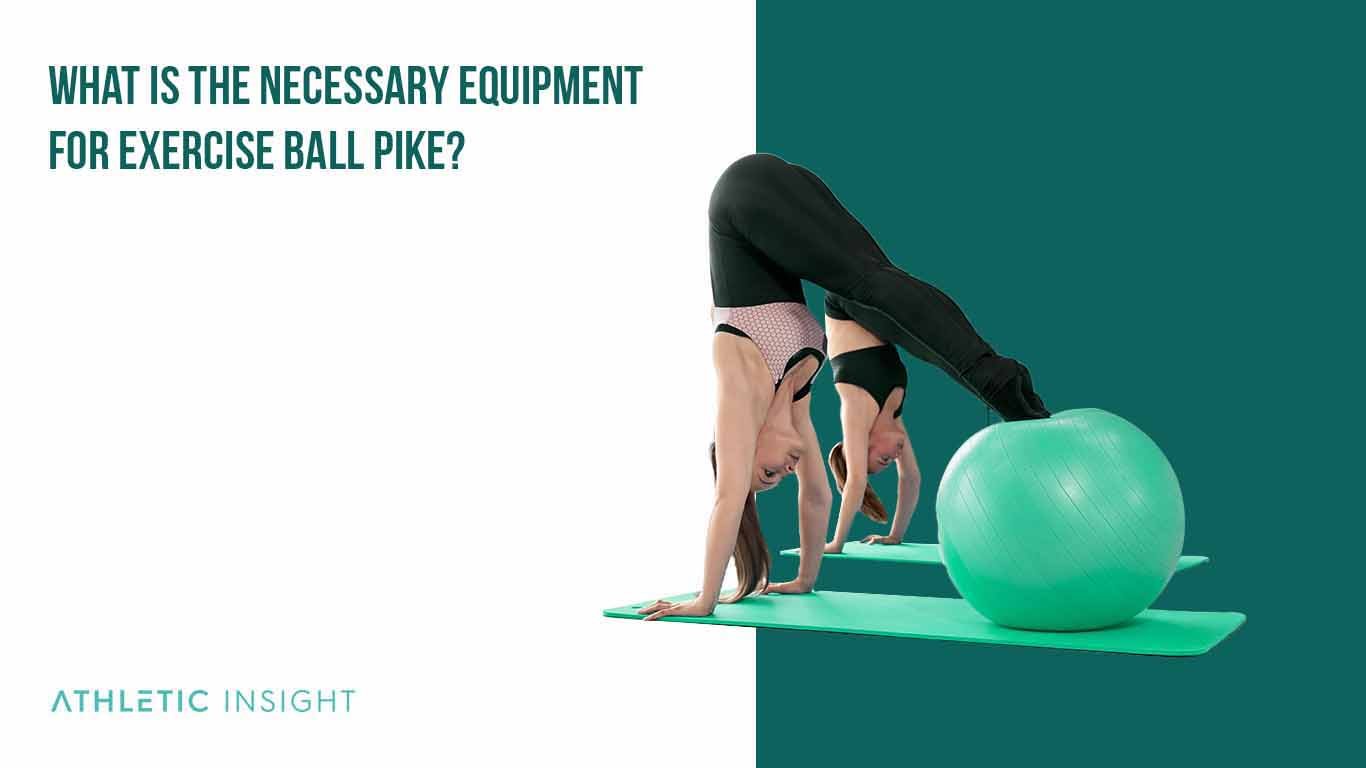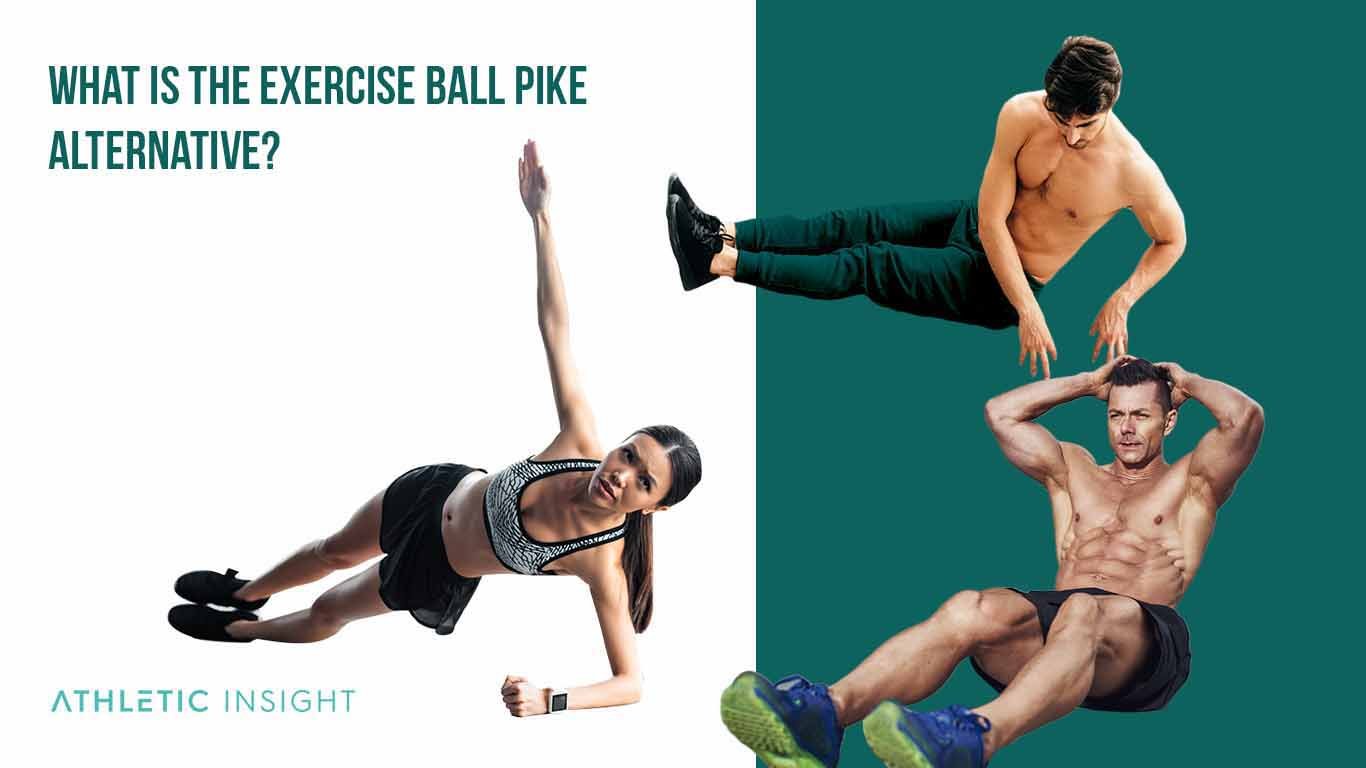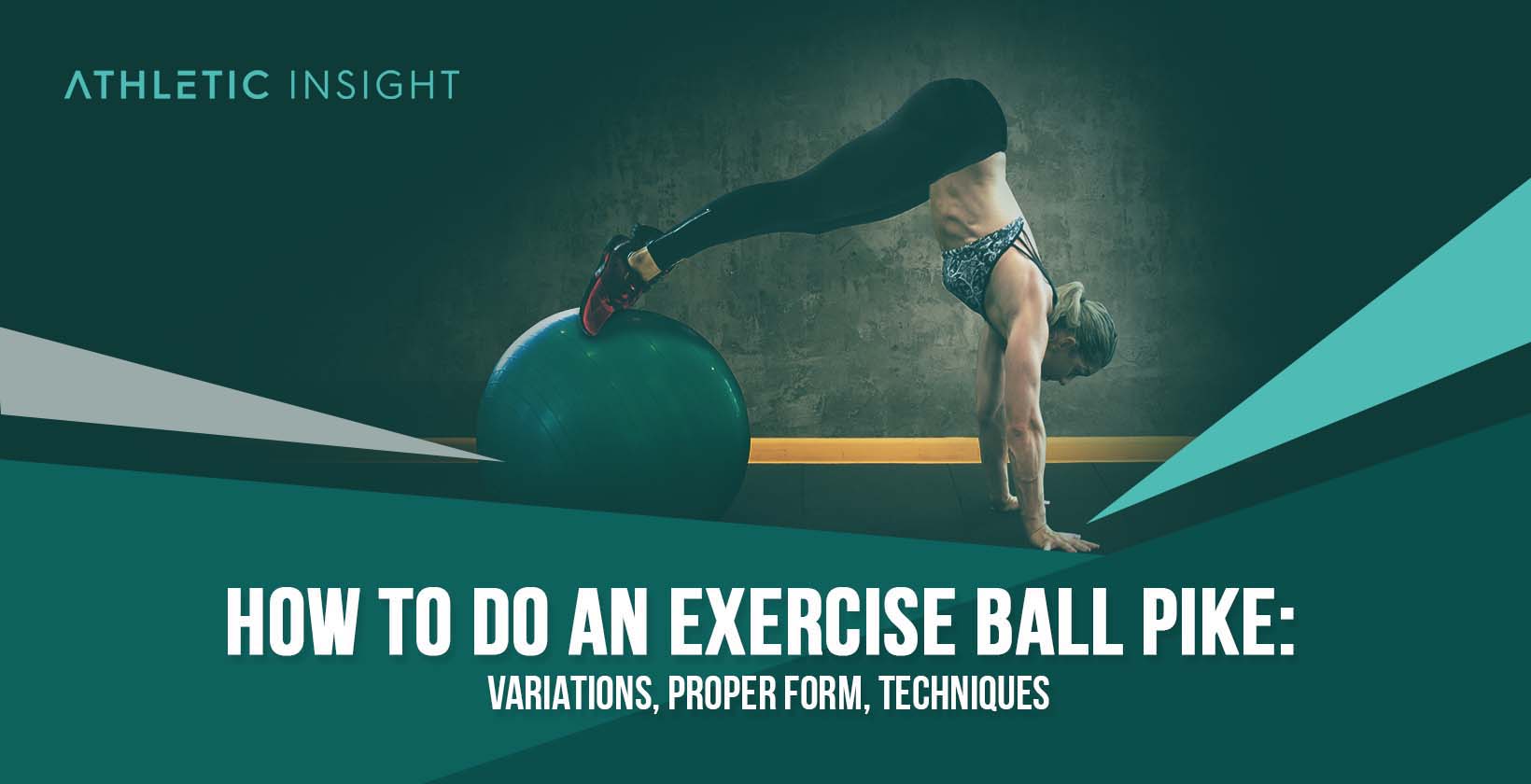The exercise ball pike is a bodyweight ab exercise that brings you through an entire range of motion to work your entire body, focusing on your core and abdominal muscles.
The benefits of the exercise ball pike are that it takes the pressure off of the other parts of your body, such as your legs, lower back, and hips. It focuses on your core and abdominal muscles to isolate your abs.
The muscles involved in the exercise ball pike strengthen your entire body but specifically focus on your abdominal muscles, hips, quadriceps, shoulders, arms, and chest. Since you are in a pike and plank position, this exercise works the deltoids, quadriceps, abductors, abdominals, triceps, and pectorals.
The proper exercise ball pike form focuses on keeping your hips high, bringing your body into an inverted V shape while keeping your hips bent, legs straight, and arms and hands touching the floor.
The main exercise ball pike variations include using an exercise ball and doing the movement without an exercise ball. It can also be done doing the movement with your feet on the exercise ball at all times.
The most common injuries from doing the exercise ball pike are straining your lower back or straining your neck. Avoid these common mistakes by using proper swiss ball pike form. Individuals should continue to practice plank pikes and yoga pikes to avoid common injuries and reap the benefits of this exercise.
How to Perform Exercise Ball Pike with Proper Form?
To dominate the ball pike exercise, individuals must do the exercise with proper form, which is doing an exercise safely and correctly without any risk of injury to the person or overuse strain.
Individuals must focus on the best swiss ball pike form to learn how to do the pike ball safely and repeatedly. By following the stability ball pike rules, individuals can safely and efficiently perform physioball pikes to strengthen their core.
- Begin with your hands shoulder-width apart and your shins on a Swiss ball.
- Roll the ball in toward your hands, raise your hips.
- Raise your hips.
- Take a brief pause at the peak.
- Steadily lower to the starting position.
- Do not allow your hips to dip below a flat line with your shoulders and feet.
What Are the Benefits of the Ball Pike Exercise?
The benefits of the ball pike exercise are abundant. When learning how to pike, individuals must perform the pike ups exercise safely and with proper form to reap the following benefits.

- Strengthens the shoulders – The deltoids stabilize the body during the entire motion.
- Strengthens Chest – The pectorals are strengthened during the plank position.
- Strengthens Arms – Arms are taxed, especially the triceps, during the plank and pike.
- Functional Strength – Learning how to plank with the ball can help build functional strength.
- Helps isolate the core muscles to take pressure off of the lower back and hip flexors
What Are the Mistakes for Exercise Ball Pike form?
Individuals must use good exercise ball pike form to avoid mistakes and injuries common with this workout. By learning exercise ball pike form, individuals can avoid mistakes and overuse injuries in the deltoids, straining the lower back, and straining the neck muscles during the entire exercise. Learning how to do the pike ab exercise and the yoga ball plank is key to avoiding mistakes and injuries.
The main exercise ball pike mistakes are going too far forward, using an exercise ball that is too big, not keeping your core tight, and extending your neck.
Which Muscles Are Involved While Performing Exercise Ball Pike?
The main muscles involved in the exercise ball pike are the deltoid muscles, pectoral muscles, abdominal muscles, quadriceps muscles, and triceps muscles. The exercise bike is a full-body exercise that works various muscles.
What Are the Exercise Ball Pike Variations?
An exercise ball pike variation is an alternative exercise that uses different equipment or motion to tax the same muscles, possibly to a different degree. Individuals can learn how to do a plank on a ball, pike pull-ups, or plank with an exercise ball to change their workout routine.
- Suspension Trainer Pike – This exercise uses a TRX machine with the same motion as the exercise ball pike.
- Glider Saw to Pike – The glider saw provides constant tension to your entire body during the range of motion.
- V-Up – The v-up does not require any equipment and can be an easier version than the swiss ball pike.
- Bench Leg Lift to Reverse Pike – This exercise uses a bench, which is easier and more stable than an exercise ball.
What Is the Necessary Equipment for Exercise Ball Pike?
Individuals need an exercise ball to perform the exercise ball pike or swiss ball roll-ins and, need a barbell to perform the best exercise ball pike barbell.

What Are the Abs Muscle Exercises with Exercise Ball Pike?
Other best abs exercises that can help your performance with the exercise ball pike are swiss ball roll-ins, pike press exercises, exercise ball pull-ins, pilates chair pikes, planks on a medicine ball, ball planks, and physioball crunches.
What Are the Exercise Ball Pike Related Facts?
Some exercise ball-related facts can influence your decision whether to use this exercise in your workout plan.
There are 3 Reasons why the Exercise Ball Pike is the best exercise:
- The exercise ball pike is a compound movement.
- The exercise ball pike can be used with minimal equipment, only needing the physioball.
- The exercise ball pike is suitable for modifications for beginners and advanced users.
Does Exercise Ball Pike Affect the Hormones?
The exercise ball pike is a resistance and bodyweight exercise that can influence the hormones, increasing the dopamine and testosterone in someone’s body.
Does Exercise Ball Pike Increase Testosterone?
Exercise ball pike can release testosterone, although less so than other resistance exercises that utilize heavyweight.
Does Exercise Ball Pike Affect the Mood?
The exercise ball pike is an exercise that can release dopamine after the workout.
Is Exercise Ball Pike Practiced Within CrossFit?
The exercise ball pike is not practiced within CrossFit but can supplement other abdominal strengthening exercises.
Is Exercise Ball Pike an Olympic lift?
The exercise ball pike is not an Olympic lift but can be used to strengthen a weightlifter’s core for its overhead weightlifting lifts.
Is Exercise Ball Pike a Compound Exercise?
The exercise ball pike is a compound exercise since it taxes multiple muscle groups.
What Is the Exercise Ball Pike Alternative?
An exercise ball pike alternative is another option for a workout besides the exercise ball pike, using other equipment or taxing the muscles to a different degree.

- Superman Exercise – Focuses on lower back muscles.
- In And Out Abs – Bodyweight exercise that is an easier version of a v-up.
- Plank – Full-body exercise that uses bodyweight resistance.
- Bird Dog – Pilates exercise for core and lower back.
- Leg Raises – Focuses on lower abdominal strength.
- Side Plank – Bodyweight exercise that taxes the core and obliques.
- Russian Twist – Focuses on obliques.
- U Crunches – Level up from regular crunches.
- Oblique Crunches – Focuses on obliques.
- Warrior Pose 3 – Full-body yoga pose that strengthens the upper and lower body.
- Burpee – Full-body cardio movement that tones the arms, chest, quadriceps, and hamstrings.
- Ab Crunches – Upper abdominal movement.
- Scorpion – Stretches the hip flexors and lower back.
- Bicycle Crunches – Taxes arms and the core.
- Downward Dog – Yoga pose for stretching the hamstrings.
- Windmill – Core stability and hip mobility.
- Reverse Crunches – Hard lower-ab exercise.
- Child Pose – Resting exercise during yoga.



